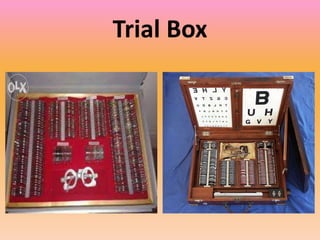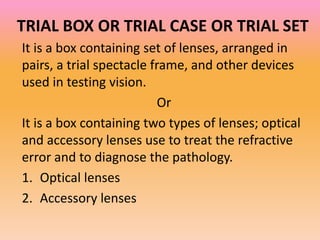Trial box
- 1. Trial Box Miss. Sobia Ehsan Lecturer (Optometrist) LRBT free eye care hospital Karachi, Pakistan
- 2. Trial Box
- 3. TRIAL BOX OR TRIAL CASE OR TRIAL SET It is a box containing set of lenses, arranged in pairs, a trial spectacle frame, and other devices used in testing vision. Or It is a box containing two types of lenses; optical and accessory lenses use to treat the refractive error and to diagnose the pathology. 1. Optical lenses 2. Accessory lenses
- 4. Uses of Trial box Objective refraction Subjective refraction Diplopia charting Diagnosis of squint Assess binocular vision
- 5. Types of lenses 1. Optical lenses Use to correct the refractive errors. 2. Accessory lenses Use to diagnose the pathology.
- 6. CONSIST ON  Trial frame  Trial lens  Prism  Accessories
- 7. TRIAL LENS During refraction the practitioner utilize a set of known lenses. Power ranging in spherical lens  Pair of positive lens range 0.12 / 0.25 – 20 D  Pair of negative lens range 0.12 / 0.25 – 20 D
- 8. RANGES SPHERICAL LENSES o-0.12 / 0.25 D o 0.25 D to 10.00 D sphere in 0.25 D steps o 10.50 D to 16.00 D sphere in 0.50 D steps o 17.00 D to .18.00 D sphere in 1.00 D steps o 18 D to 20.00 D sphere in 2.00 D steps
- 9. RANGES Cylindrical lenses o 6 pairs of Cylindrical lenses o Pair of positive lenses ranging +0.12 - +6.00D oPair of negative lenses ranging -0.12 - 6.00D o -0.25 DC to -3.00 DC in -0.25 steps o -3.50 DC to -6.00 DC in -0.50 steps
- 10. PRISM Power range of :  ½(0.5)D 1- 6.00D in 1D steps  6- 12.D in 2D steps Base of prism Uses To correct & measure Strabismus Exercising prism Measure the fusional range
- 11. Prism
- 12. ACCESSORIES Plano lens Red and green filter Maddox rod Stenopaic slit Occluder Pin hole Jackson cross cylinder
- 13. ACCESSORIES PLANO LENS It is used for satisfy & identify the malingering patients. OCCLUDER It is an opaque plastic disc, occlude one eye to relax accommodation. Used to dissociate fusion & Used to close one eye while the other eye can be tested for visual acuity.
- 14. ACCESSORIES MADDOX ROD It is made up of several series of high plus Plano cylindrical lenses.  Patient sees streak of light through this lens  Available in red and white in colour Used as single and double Maddox rod depends upon the test USES To detect heterophoria To detect cyclophoria To measure the squint deviation To detect orthophoria
- 15. ACCESSORIES STENOPAEIC SLIT It has slit of 1mm width & 25mm in length It allows strip of light to pass through the cornea. USES To find out axis of cylinder + or – To find out weather patient is having astigmatism Vertex distance can also measureable
- 16. ACCESSORIES RED AND GREEN FILTER Red in RE & Green in LE Used for color dissociation Used to find out suppression of eyes To find out diplopia To do worth 4 dot test & FRIEND test Used to measure the Fusion , squint
- 17. FROSTED LENS This is a kind of half-transparent or translucent plane cover lens which mainly replace black lens for baby and outdoor activity.
- 18. CROSS LENS • There are two mutual vertical lines on the plain lens. Optical use • It can be used for looking for the pupil center and measuring intraocular distance.
- 19. CROSS CYLINDER LENS It is a sphero-cylindrical lens, in which the power of cylinder is twice the power of sphere with opposite signs placed with their axis at right angles to each other and mounted in a handle. USE Used to examine the axis and power of cylinder
- 20. Trial frame Trial frame is an adjustable frame that is used with trial lenses when measuring the patients for spectacle lenses. The pupillary distance,lens height ,cylinder axis can be set to accommodate the patients size. It consist of 4 case. Front case is for cylindrical lens, back case for high myopic lens, other for additional lens and Occluder.
- 21. Pinhole Pinhole consist on opaque disc with a Pinhole. Optical function of Pinhole: Pinhole allows the passage of central rays of light. This permits the formation of clear image. Uses of Pinhole: If patient’s vision improves with pinhole, patient is having uncorrected refractive error. If patient’s vision is not improving then patient may have any pathological defect or neurological defect of the eye.























